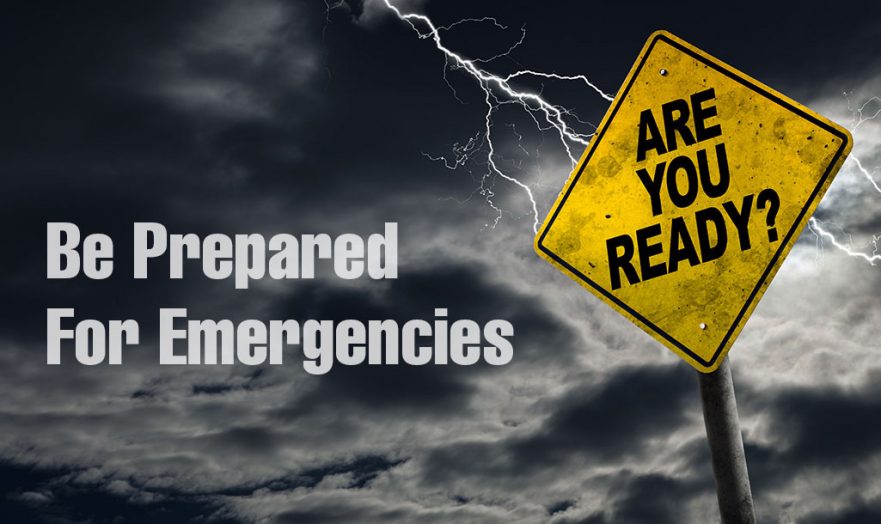Being prepared could save your business
A natural disaster can strike no matter where you live in the U.S. You have hurricanes on the east coast, earthquakes on the west coast, and tornadoes in the middle. In this two-part series, we look at the importance of developing an emergency plan and the basic steps to take in either a natural or human-created emergency.
So, why is it so important to have a well-developed emergency action plan? According to studies conducted by the Gartner Group in recent years, 60 percent of businesses are unprepared for disasters and emergencies, and 40 percent of companies that experience a disaster go out of business within five years (EmergencyPlan.com). Without a well-defined emergency plan, your company will likely struggle or fail to remain in business after an emergency.
The purpose of an emergency plan is to organize actions during an emergency. A well-developed workplace emergency strategy and proper employee training may result in fewer injuries to employees and customers and less structural damage to the business.
The following three sections should be included in your plan:
- Emergency Preparedness
- Emergency response
- Disaster recovery
It is the responsibility of the owner and management team to evaluate an emergency situation, ensure that appropriate action is taken, determine if outside support is needed, and summon that support, if necessary.
Management should have valid phone numbers for all employees. They should also post their own mobile and home phone numbers in case employees need to contact them in the event of an emergency.
Evacuation Procedures
Follow these evacuation procedures for naturally occurring or weather-related emergencies.
- Post a diagram of all evacuation routes in the break area or back room.
- Move employees, and others who are closest to the danger, to a sage area near, or at, an emergency exit.
- Direct all persons to evacuate the building through the nearest safe exit.
- Assist anyone with mobility issues.
- Ensure no one is left in the building.
- Employees who have been assigned a safety function should be the last to exit the building whenever possible.
- Assign one employee to take the first-aid kit as they leave the building.
- Notify the police and fire department by dialing 911.
Naturally-Occurring Emergencies
Floods, including flash flooding from area creeks, lakes, and rivers may occur with or without warning. The store should monitor weather updates during a storm and have a plan as to how to move merchandise to minimize its exposure to water. All electrical devices, such as TVs, DVRs, gaming systems, DVD players, computers, and cash registers, should be unplugged and moved to an area that would not be affected by the water. Any merchandise displayed outdoors should be brought inside. The manager should monitor the water level in the area as well as any low-water crossings surrounding the store and should consult the owner as to when the store should be evacuated. Nobody should be driving during flash flooding conditions.
Tornado, conditions generally occur with little warning. The store should designate a small interior room in which to gather in the event of a tornado. This room should be as free as possible of items that could become projectiles during the storm. If no such room is present, select a spot as far away as possible from any glass. When a tornado alert occurs, the manager should lock the front door and instruct all employees and customers to go to the interior until the tornado warning is over.
Hurricanes and Tropical Storms generally provide some warning. The store should use the plan developed for floods to minimize the exposure of the merchandise to water and to make sure all electrical devices are unplugged. As in the case of a flood, the store should bring in any merchandise that is displayed outdoors. Prior to the storm, employees should be instructed whether to board up or tape the store’s glass front. If the store is to close early, the manager should make a bank deposit, if possible, and check the alarm backup system before leaving.
Winter Storms and Blizzards may or may not provide a warning. The store should have sufficient tools to clear a path from the store. Additionally, the store should have a supply of salt or ant-icing chemical to clear ice buildup on the walkways. When blizzard conditions occur, or the snow accumulation reaches crisis levels, all electrical merchandise should be unplugged. Any area of the store that is prone to leaks should have merchandise removed from that area. The manager on duty should monitor the snow levels and consult with the owner as to when the store should be evacuated. This decision should focus on the employees’ welfare as opposed to merchandise. Road conditions should also be considered so that you do not evacuate the store and put your employees on unsafe roadways.
Every store should have “emergency supplies” ready in case of an emergency. These supplies should be stored in the manager’s office or in a safe, accessible location at the back of the store.
Your emergency supply list should include:
- Battery-operated flashlight
- Battery-operated radio
- Extra batteries to fit the flashlight and radio
- First-aid kit
- Water
- Blankets
- Fire extinguisher
- Emergency whistle or air horn
Important: If the store is to be closed due to any emergency situation, the safe should be filled with as much of the company assets as possible i.e., cash, jewelry, small general merchandise loans, or inventory, before leaving. Use your safe as your “lifeboat” during an emergency. Safes are designed to withstand long periods of attacks from thieves and most will not be able to get into a safe no matter how long they attack it.

